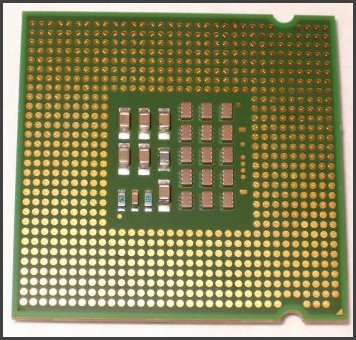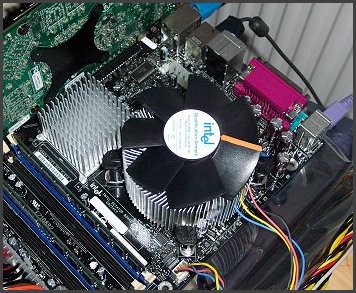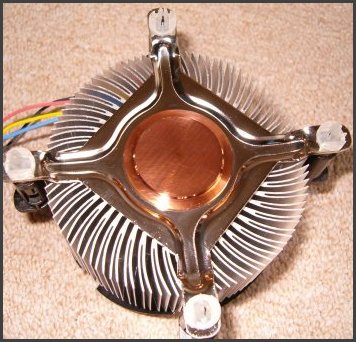LGA775
Intel's LGA775, or Socket T as it's most likely going to become known in the future, is a completely new way of interfacing the new Pentium 4 processors to their system bus, with the northbridge lying at the far end. Internally, the initial crop of new processors are identical to the outgoing Socket 478 versions, so the explanation for the extra 297 pins isn't as easy as "the memory controller is on the CPU" or "there are dual cores in the package".Intel have hit something of a brick wall, in terms of thermal packaging and electrical signalling, when designing the power delivery and thermal systems for their clock-happy NetBurst microprocessors. While it's quite possible to use existing Socket 478 to drive Pentium 4 processors well into the median 4GHz range, doing so with stock CPU voltages and air cooling is impossible.
To allow for those kinds of speeds at a sane voltage using air cooling has required a rethink in the way the processor is packaged. While the new processors outwardly appear to be very similar to Socket 478 chips, the reality is slightly different. The extra pins on the LGA775 socket that interface with the processor allow for a different power delivery mechanism to the processor package, the vast majority of the new pins being voltage pins for power.
The heatspreader design is also tweaked for slightly better thermal delivery to the cooling solution you'll strap on top, with the socket retention mechanism and socket area redesigned to accomodate the larger heatsinks that high speed LGA775 processors are going to need, more pressure now able to be exerted on the heatspreader by the CPU, due to the socket enclosure.
Obviously that means the entire socket and socket area has been redesigned, so let's take a closer look.
The Socket
The photograph above, while having sufficient detail for a quick analysis, isn't enough for the details, so go ahead and open the larger linked picture in a new brower window for a closer look.
The biggest obvious change, although very well known by now, is that the socket carries the interface pins, not the processor. You'll have heard people cry foul, indicating that it's now very easy to damage the socket while wondering why the pins have been removed from the processor. During the course of my own testing I encountered no issues, but it's worth mentioning the reservations of the mainboard manufacturers and their engineers, with regards to the socket change.
Mainboard manufacturers rely upon an RMA rate not exceeding some 2%, but the expectation is that this - more fragile - socket will cause RMA rates to spiral well into double figures, and so we empathise with their concerns regarding profitability, and of course increased support costs right through the chain of sale, from distribution through to retailers.
Another concern is with LGA775/Socket T's increased cost. Presently the price of a Socket 478 assembly for integration onto a mainboard is less that USD$1, whilst the new Socket T apparently costs almost tenfold more. Of course every increase in cost ultimately ends up being passed to the motherboard vendor and inturn onto you, the end user.
With all that in mind, from my own testing you'd have to be extremely cack-handed to damage an LGA775 socket during a CPU swap. Unclip the lever, slowly raise it up, lift open the clamshell retainer, grab the CPU using thumb and forefinger where I've marked the green areas in the bigger photograph, lift straight up. Reverse the process to put a new CPU in. Drop it in gently without any sideways movement, drop the retainer over the top, close the lever gently, clip it under its retainer. I did that thirty times without issue.
Placing the processor back into the socket is easy. Line up the notches on the CPU package with the notches on the socket (marked in green on the photographs) and et voila, you're done.
The socket design is also a means to better CPU thermal performance, since it allows the heatsink to exert more pressure on the CPU's heatspreader, since the CPU is now clamped inside the socket assembly. You'll remember initial Pentium 4 motherboards visibly bowing around the socket area as the heatsink was attached, with Intel forced to relax that pressure in future designs, due to issues with removing CPUs from the tensioned socket assembly. Now that extra force is again free to be exerted with LGA775. More force exerted on the CPU heatspreader by the heatsink is a means to moving heat a bit more efficiently.
Let's take a closer look at the new processor packaging.
The Processor Package
The photograph above shows the CPU held into its plastic protector, which you can see gripping the CPU on all 4 sides. The heatspreader is slightly redesigned so that it works with the LGA775 clamshell retainer. The bottom of the processor is the interesting part, since the pins now reside in the socket on the motherboard.
The rear of the processor (in this case the 3.4GHz Extreme Edition) shows you their pin-free nature. The pins in the socket now interface with the slightly recessed contact pads. The recess allows for slight purchase on the pins by the CPU.
Click here for a photograph of the rear of the Pentium 4 560 (3.6GHz Prescott).
The Cooler
With the change in socket and processor comes a change in the default cooler. The socket area on LGA775 motherboards no longer has a retention bracket, like with Socket 478 (and indeed Socket 754/939/940). However, the specification does lay out an area on the motherboard that no components may impinge on, giving the new heatsink plenty of room. It attaches by the means of locked push pins, pushed through the four corners of the socket area.The heatsink itself is a large multi-finned affair made from aluminium with a copper base, combined with a new fan design. The fan has large blades and uses speed control via voltage adjustment from the motherboard, depending on temperature or user settings. It has a 4-pin connector, but not regular Molex style, since it needs wires for speed monitoring.
It's a rediculously simple cooler to attach to the new socket, the push-lock legs doing all the hard work in making it so. A nice design in this reviewer's opinion.
On the reference motherboard, the fan spins at a very lazy 500rpm at default thermal settings. The option exists to allow the fan to completely stop, should monitored temperatures drop below a certain threshold. More on those options later in the examination of the reference desktop board.














